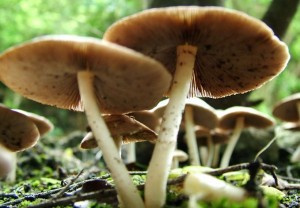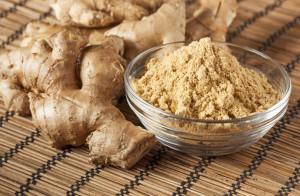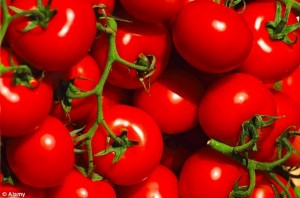 By now, it shouldn’t be a secret that there are specific proteins, enzymes and other coding within our bodies that can be activated to stop cancer cells dead in their tracks. Every day, more and more people (including doctors and scientists) are learning about the powers of specific foods and the role they play in our diet to both prevent and fight diseases. When it comes to cancer – which is such a widespread problem, so it naturally garners more attention – there are certain foods and compounds contained within certain foods that are thought to destroy cancer cells, along with having numerous other health benefits. Below are 10 of the most functional foods in the world that destroy cancer cells.
By now, it shouldn’t be a secret that there are specific proteins, enzymes and other coding within our bodies that can be activated to stop cancer cells dead in their tracks. Every day, more and more people (including doctors and scientists) are learning about the powers of specific foods and the role they play in our diet to both prevent and fight diseases. When it comes to cancer – which is such a widespread problem, so it naturally garners more attention – there are certain foods and compounds contained within certain foods that are thought to destroy cancer cells, along with having numerous other health benefits. Below are 10 of the most functional foods in the world that destroy cancer cells.
#1: Grapes and Resveratrol (found in Wine)
 Resveratrol, the powerful ingredient found in grapes and wine, is an extremely powerful antioxidant. It is known for its ability to inhibit cyclooxygenase-2 (CoX-2) production, which is related to cancers and other types of non-malignant tumors/growths in the intestinal tract. Organically-occurring CoX-2 inhibitors such as resveratrol have been shown to decrease the incidence of cancer along with pre-cancerous growths. So maybe that extra glass of wine isn’t so bad after all!
Resveratrol, the powerful ingredient found in grapes and wine, is an extremely powerful antioxidant. It is known for its ability to inhibit cyclooxygenase-2 (CoX-2) production, which is related to cancers and other types of non-malignant tumors/growths in the intestinal tract. Organically-occurring CoX-2 inhibitors such as resveratrol have been shown to decrease the incidence of cancer along with pre-cancerous growths. So maybe that extra glass of wine isn’t so bad after all!
#2: Sea Vegetables
 If you’ve never had an interest in sampling one of the many vegetables found in the sea, you might want to think about giving them a try. Sea vegetables such as Nori, Arame, Kombu and Wakame are examples of sea vegetables that can help fight cancer. These tasty sea vegetables contain a variety of antioxidant and anti-inflammatory compounds that will help prevent and reverse the damage done by foods and other factors that cause inflammation and oxidative stress – two known contributing factors to many types of cancers.
If you’ve never had an interest in sampling one of the many vegetables found in the sea, you might want to think about giving them a try. Sea vegetables such as Nori, Arame, Kombu and Wakame are examples of sea vegetables that can help fight cancer. These tasty sea vegetables contain a variety of antioxidant and anti-inflammatory compounds that will help prevent and reverse the damage done by foods and other factors that cause inflammation and oxidative stress – two known contributing factors to many types of cancers.
#3: Turmeric (spice)
 The prized ingredient in the spice Turmeric is Curcumin, and it is typically found in most Indian dishes. Curcumin is considered to be an extremely powerful antioxidant and anti-inflammatory that reduces the metastases of tumors and thus can destroy cancer cells, along with preventing the growth and spread of cancer cells in the first place. A popular research study at Johns Hopkins reviewed and summarized over 700 studies on Turmeric and concluded that it outperforms many pharmaceutical drugs in its effects on a number of chronic diseases – and does so without almost zero side effects.
The prized ingredient in the spice Turmeric is Curcumin, and it is typically found in most Indian dishes. Curcumin is considered to be an extremely powerful antioxidant and anti-inflammatory that reduces the metastases of tumors and thus can destroy cancer cells, along with preventing the growth and spread of cancer cells in the first place. A popular research study at Johns Hopkins reviewed and summarized over 700 studies on Turmeric and concluded that it outperforms many pharmaceutical drugs in its effects on a number of chronic diseases – and does so without almost zero side effects.
#4: Green Tea
 Green tea owes its cancer-destroying abilities to a group of plant flavonoids it contains known as catechins. One of these catechins – epigallocatechin-3-O-gallate (EGCG) – has been shown to create a process that disrupts the ability of inflammatory chemicals to bind to the cells of smooth muscle tissues found within the vascular system. This is a critical function of the catechin, because the same process is known to disrupt the development of cancer cells.
Green tea owes its cancer-destroying abilities to a group of plant flavonoids it contains known as catechins. One of these catechins – epigallocatechin-3-O-gallate (EGCG) – has been shown to create a process that disrupts the ability of inflammatory chemicals to bind to the cells of smooth muscle tissues found within the vascular system. This is a critical function of the catechin, because the same process is known to disrupt the development of cancer cells.
#5: Cruciferous Vegetables
 Cruciferous vegetables like broccoli, arugula, cabbage, cauliflower and kale (to name just a few) contain organic chemical compounds known as glucosinolates. Apart from being extremely high in a number of important vitamins, minerals and enzymes that our body craves on a daily basis, these cruciferous vegetables are known to create compounds (thanks to the glucosinolates) which can fight cancer. You may not love your veggies, but you should certainly try and make them a part of your daily diet!
Cruciferous vegetables like broccoli, arugula, cabbage, cauliflower and kale (to name just a few) contain organic chemical compounds known as glucosinolates. Apart from being extremely high in a number of important vitamins, minerals and enzymes that our body craves on a daily basis, these cruciferous vegetables are known to create compounds (thanks to the glucosinolates) which can fight cancer. You may not love your veggies, but you should certainly try and make them a part of your daily diet!
#6: Garlic
 A study published online in the journal Cancer Prevention Research details how garlic has been used since around 2000 BC in ancient Chinese medicine. The study suggests that a compound found in garlic called diallyl sulfide is one of the key ingredients in garlic that gives it cancer-fighting powers. Another compound found in garlic called Allicin is considered to be one of the most powerful antioxidants known to man. Powerful antioxidants – along with having many other health benefits – are though to be a contributing factor in the destruction of certain types of cancers.
A study published online in the journal Cancer Prevention Research details how garlic has been used since around 2000 BC in ancient Chinese medicine. The study suggests that a compound found in garlic called diallyl sulfide is one of the key ingredients in garlic that gives it cancer-fighting powers. Another compound found in garlic called Allicin is considered to be one of the most powerful antioxidants known to man. Powerful antioxidants – along with having many other health benefits – are though to be a contributing factor in the destruction of certain types of cancers.
#7: Hempseed Oil
 Hemp oil is known to speed up the healing process throughout the body and also raise melatonin levels. Melatonin has been shown to reduce or even completely stop the growth of certain types of cancers, so the extra production of it thanks to hemp oil is a great asset in your body’s fight against cancer. Hemp oil can be consumed through gel-caps or even directly out of the bottle. However, I recommend adding it to a smoothie or juice to help mask the taste – you won’t even know it’s there, but your body will thank you.
Hemp oil is known to speed up the healing process throughout the body and also raise melatonin levels. Melatonin has been shown to reduce or even completely stop the growth of certain types of cancers, so the extra production of it thanks to hemp oil is a great asset in your body’s fight against cancer. Hemp oil can be consumed through gel-caps or even directly out of the bottle. However, I recommend adding it to a smoothie or juice to help mask the taste – you won’t even know it’s there, but your body will thank you.
#8: Mushrooms
 There are over 50 different species of mushrooms that have anti-viral and anti-cancer effects which have been proven through numerous in-vitro and animal research studies. Mushrooms have been used for over 5,000 years in ancient and traditional medicines due to their powerful effects on a number of diseases and conditions – including cancer.
There are over 50 different species of mushrooms that have anti-viral and anti-cancer effects which have been proven through numerous in-vitro and animal research studies. Mushrooms have been used for over 5,000 years in ancient and traditional medicines due to their powerful effects on a number of diseases and conditions – including cancer.
#9: Ginger
 Certain compounds found within Ginger make it a powerful anti-inflammatory and antioxdiant, which means it works to reduce the oxidative stress and inflammation that your body has to fight on a daily basis. Studies have shown that Ginger can reduce cancerous tumors by as much as 56% and have also shown it to be a more effective remedy than traditional medical treatments like chemotherapy in the case of certain types of cancers.
Certain compounds found within Ginger make it a powerful anti-inflammatory and antioxdiant, which means it works to reduce the oxidative stress and inflammation that your body has to fight on a daily basis. Studies have shown that Ginger can reduce cancerous tumors by as much as 56% and have also shown it to be a more effective remedy than traditional medical treatments like chemotherapy in the case of certain types of cancers.
#10: Tomatoes
 Most people love tomatoes, so I wouldn’t be surprised if they’re already a part of your regular diet. But did you know they’re a powerful food in the fight against cancer? Tomatoes contain Lycopene, a compound known for its ability to destroy cancer cells. They can help reduce inflammation and oxidative stress throughout the body and one study showed that inflammation was reduced by 30% from simply consuming 1 glass of fresh tomato juice per day for a month straight.
Most people love tomatoes, so I wouldn’t be surprised if they’re already a part of your regular diet. But did you know they’re a powerful food in the fight against cancer? Tomatoes contain Lycopene, a compound known for its ability to destroy cancer cells. They can help reduce inflammation and oxidative stress throughout the body and one study showed that inflammation was reduced by 30% from simply consuming 1 glass of fresh tomato juice per day for a month straight.
BUT be FOREWARNED: Certified Organic Food Grown in U.S. Found Contaminated with Glyphosate Herbicide
Written for and published at Better Daily Habits.
FAIR USE NOTICE: This site contains copyrighted material the use of which has not always been specifically authorized by the copyright owner. We are making such material available in our efforts to advance understanding of environmental, political, human rights, economic, democracy, scientific, and social justice issues, etc. We believe this constitutes a ‘fair use’ of any such copyrighted material as provided for in section 107 of the US Copyright Law. In accordance with Title 17 U. S. C. Section 107, the material on this site is distributed without profit to those who have expressed a prior interest in receiving the included information for research and educational purposes. For more information go to: http://www.law.cornell.edu/uscode/17/107.shtml
